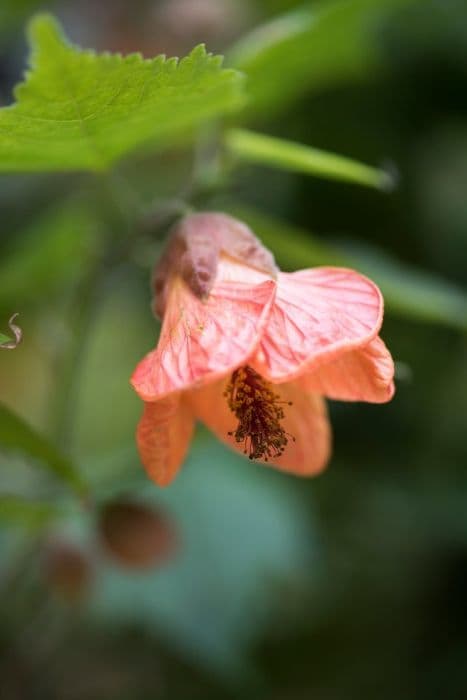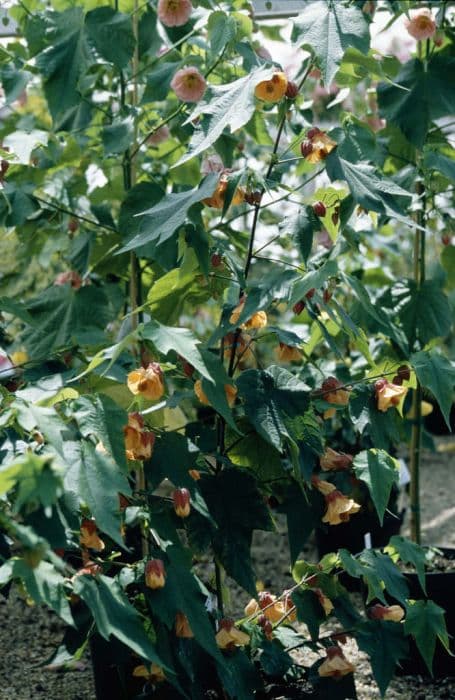Silver Linden Tilia tomentosa 'Petiolaris'

ABOUT
The plant commonly known as the Silver Linden has a unique and striking appearance that makes it stand out in any landscape. This cultivated variety has dark green leaves with a silvery underside that catches the light, giving a shimmering effect when the wind blows through the canopy. The leaves are heart-shaped with a serrated edge and attach to the branches with a notably long leaf stalk, which helps them flutter attractively in the breeze. In the spring and early summer, the Silver Linden produces clusters of yellow-white, sweetly fragrant flowers, which are especially attractive to bees. The flowers hang in a drooping fashion beneath the branches and add an ornamental quality to the tree. After flowering, small nutlets enclosed by a leafy bract appear and persist into the autumn. During autumn, the leaves change color from their lush summer green to a variety of fall colors, including yellow and bronze, before they drop, leaving behind a stark but structured winter silhouette complete with sturdy branches and a strong central trunk. Its bark is gray to light brown, often with a somewhat flaky texture that adds to its winter appeal. The Silver Linden is appreciated for its aesthetic qualities, with its contrasting foliage and striking seasonal changes providing year-round interest. Its suitability for urban settings is further enhanced by its tolerance to pollution and its ability to provide welcome summer shade with its dense canopy.
About this plant
 Names
NamesFamily
Malvaceae.
Synonyms
Silver Lime, Weeping Silver Lime, Silver Linden, Pendant Silver Lime.
Common names
Tilia tomentosa 'Pendula', Tilia petiolaris.
 Toxicity
ToxicityTo humans
The Silver Linden tree is not notably toxic to humans. There are no well-documented cases of poisoning from ingesting any parts of this plant. Consuming leaves or any other part of the Silver Linden tree is unlikely to result in toxic consequences for humans.
To pets
The Silver Linden tree is not known to be toxic to pets. It does not contain compounds that are generally considered harmful to animals. There should be no significant symptoms of poisoning in pets from ingesting parts of the Silver Linden tree, and it is not associated with serious health consequences for pets.
 Characteristics
CharacteristicsLife cycle
Perennials
Foliage type
Deciduous
Color of leaves
Green
Flower color
Yellow
Height
50-70 feet (15-21 meters)
Spread
35-50 feet (10-15 meters)
Plant type
Tree
Hardiness zones
4
Native area
Southeastern Europe
Benefits
 General Benefits
General Benefits- Shade Provider: Silver Linden trees, like Tilia tomentosa 'Petiolaris', are known for their dense foliage which creates a cooling shade, making them excellent for landscaping and reducing heat in urban areas.
- Aesthetic Appeal: With their attractive silvery-green leaves and attractive form, Silver Lindens add visual interest to gardens and streetscapes, enhancing overall curb appeal.
- Wildlife Habitat: These trees offer habitat and food sources for various wildlife, including birds and pollinators like bees, contributing to biodiversity.
- Seasonal Interest: Silver Lindens offer seasonal interest with their fragrant flowers in summer and golden-yellow fall foliage, providing year-round visual changes.
- Urban Tolerance: They are tolerant of urban conditions, including pollution and soil compaction, making them suitable for city planting and tough environments.
- Low Maintenance: Once established, Silver Lindens require minimal care, making them a low-maintenance option for both public and private landscapes.
- Canopy Formation: Their broad canopy can help in reducing noise pollution and can serve as a windbreak, providing additional environmental benefits.
 Medical Properties
Medical Properties- Antioxidant: Tilia tomentosa 'Petiolaris', commonly known as silver linden, may contain compounds with antioxidant properties.
- Anxiolytic: The plant has traditionally been used to help reduce anxiety and promote relaxation.
- Anti-inflammatory: Silver linden might have anti-inflammatory effects that could potentially help to soothe inflammation.
- Sedative: The flowers of silver linden are historically used to make teas that can have sedative effects.
- Diaphoretic: The plant can induce sweating and is sometimes used to help with fever management.
- Antispasmodic: Silver linden is reputed to relieve muscle spasms, which might help with various types of cramps.
- Expectorant: It has been used to help alleviate symptoms of coughs and colds, functioning as an expectorant.
 Air-purifying Qualities
Air-purifying QualitiesThis plant is not specifically known for air purifying qualities.
 Other Uses
Other Uses- Silver linden wood is often used in carpentry for its fine grain and workability, making it suitable for creating intricate wooden items like musical instruments and turned objects.
- Due to its dense foliage, it can serve as a sound barrier in urban areas where noise pollution is an issue.
- The tree's nectar-rich flowers are known to attract bees, making it a valuable plant for supporting local bee populations and promoting biodiversity.
- Silver linden leaves can be used as a natural dye source, providing shades of yellow or green depending on the mordant used in the dyeing process.
- These trees can be planted in a row to form a living fence or privacy screen, making them a functional and attractive landscaping choice.
- As a shade tree, it's known for its ability to cool down the surrounding environment, providing relief in urban heat islands.
- The strong and flexible fibrous bark of the silver linden has been traditionally utilized for crafting ropes and mats in some cultures.
- During autumn, the fallen leaves can be collected and used as a nutrient-rich mulch for gardens and landscapes.
- The silver linden is sometimes used in topiary, as it can be pruned and shaped into various formal designs for ornamental gardens.
- Its dense branches make it an excellent habitat for various bird species, offering both nesting sites and protection from predators.
Interesting Facts
 Feng Shui
Feng ShuiThe Silver Linden is not used in Feng Shui practice.
 Zodiac Sign Compitability
Zodiac Sign CompitabilityThe Silver Linden is not used in astrology practice.
 Plant Symbolism
Plant Symbolism- Love: The Silver Linden Tree is often associated with love, possibly due to the heart-shaped leaves and the tree's longevity, symbolizing enduring affection.
- Peace: In European folklore, linden trees are considered trees of peace and it is said that treaties and surrenders were often signed under their canopies.
- Friendship: These trees are known to be social hubs in rural communities, their pleasant shade often hosts gatherings, thus symbolizing friendship and camaraderie.
- Justice: Historically, the linden tree is a symbol for justice. In Germanic and Slavic cultures, judicial matters were sometimes settled beneath linden trees.
- Domestic Tranquility: The Silver Linden Tree's presence in home gardens is symbolic of a tranquil domestic life, emphasizing a serene living environment.
- Healing: Since various parts of the tree are used in traditional medicine, it also symbolizes healing and recuperation.
 Water
WaterThe Silver Linden should be watered thoroughly, ensuring that the soil is moist but not waterlogged. During the growing season, it generally needs about 1.5 to 2.5 gallons of water per week, depending on the size of the tree and environmental conditions. It's important to water the tree deeply to encourage root growth, which means slowly applying water at the base until it penetrates several inches into the soil. In periods of drought or extreme heat, you may need to water more frequently, while in cooler, rainy conditions, you can water less often. Reduce watering in the winter when the tree is dormant.
 Light
LightThe Silver Linden thrives in full sun to partial shade. It performs best when it receives at least four to six hours of direct, unfiltered sunlight per day. The ideal spot for planting is an area that gets bright, morning sunlight with some afternoon shade to protect from the intense heat of the day, especially in warmer climates.
 Temperature
TemperatureSilver Lindens are hardy and can withstand a broad range of temperatures, typically from about -30 to 90 degrees Fahrenheit. They are tolerant of urban conditions and can survive cold winters. The ideal temperature for robust growth and health is between 50 and 70 degrees Fahrenheit.
 Pruning
PruningPrune Silver Lindens to remove dead or crossing branches, to shape the tree, and to facilitate healthy growth. The best time to prune is in late winter or early spring before new growth starts. Pruning is typically recommended every 3-5 years, and it's crucial to use clean, sharp tools to make precise cuts.
 Cleaning
CleaningNot needed
 Soil
SoilSilver Linden prefers well-drained, fertile loam with a pH of 6.5-7.5. The best soil mix can be created by blending equal parts of loam, peat, and sharp sand to ensure good drainage and fertility.
 Repotting
RepottingSilver Linden trees are not commonly grown in containers and therefore do not require frequent repotting. When planted in the ground, they can grow without being moved for decades.
 Humidity & Misting
Humidity & MistingSilver Linden trees are adaptable to outdoor humidity levels and do not require specific humidity conditions when planted in their natural environment.
 Suitable locations
Suitable locationsIndoor
Not ideal for indoor growth due to size.
Outdoor
Plant in full sun to partial shade, ensure fertile, well-draining soil.
Hardiness zone
4-7 USDA
 Life cycle
Life cycleThe Silver Lime or Silver Linden ('Tilia tomentosa' 'Petiolaris') begins its life cycle when a seed germinates in spring, given appropriate conditions of moisture and temperature. The seedling develops into a juvenile tree, establishing its root system and producing its first leaves, which are covered with a distinctive silver-white tomentum on the underside. As it grows, the tree enters a vegetative state where it increases in height and branch structure each year. The tree reaches maturity and begins its reproductive phase, typically flowering in mid-summer, where fragrant, pale yellow flowers attract pollinators, primarily bees. Following pollination, the tree produces small nut-like fruits called samaras, which are dispersed by wind, allowing for the continuation of its species. Silver Lindens can live for several hundred years, going through cycles of reproduction, growth, and dormancy annually until they eventually senesce and die.
 Propogation
PropogationPropogation time
Spring-Early Summer
The most popular method of propagating Silver Linden (Tilia tomentosa 'Petiolaris') is through softwood cuttings. This technique is typically employed in late spring or early summer when new growth is still tender and flexible. Cuttings should be about 6 to 8 inches (15 to 20 centimeters) long and include several sets of leaves. The lower leaves are removed, and the cut end is dipped in a rooting hormone before planting in a well-draining soil mix. The cuttings should be kept moist and in a location with indirect sunlight until roots develop, which usually takes a few weeks. After rooting, the young plants can be gradually acclimated to outdoor conditions before being transplanted into their permanent location.









